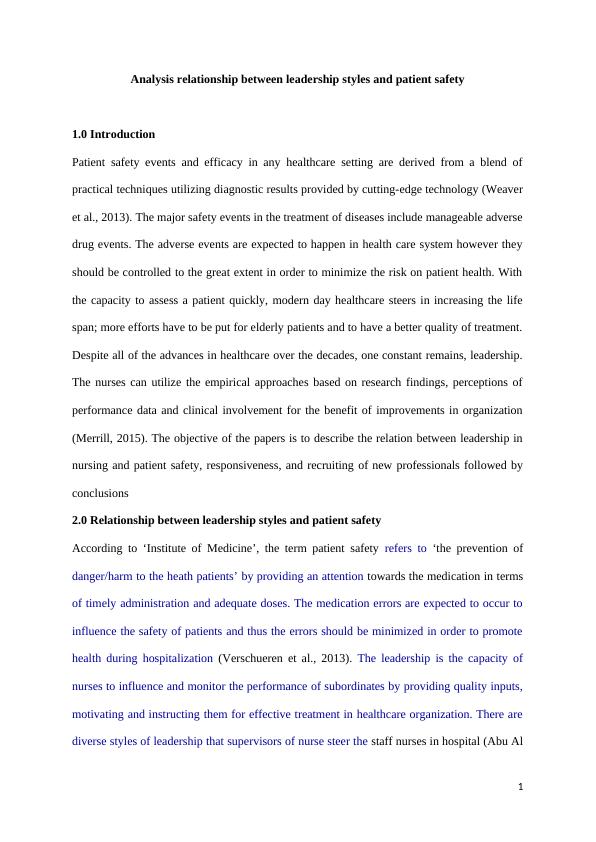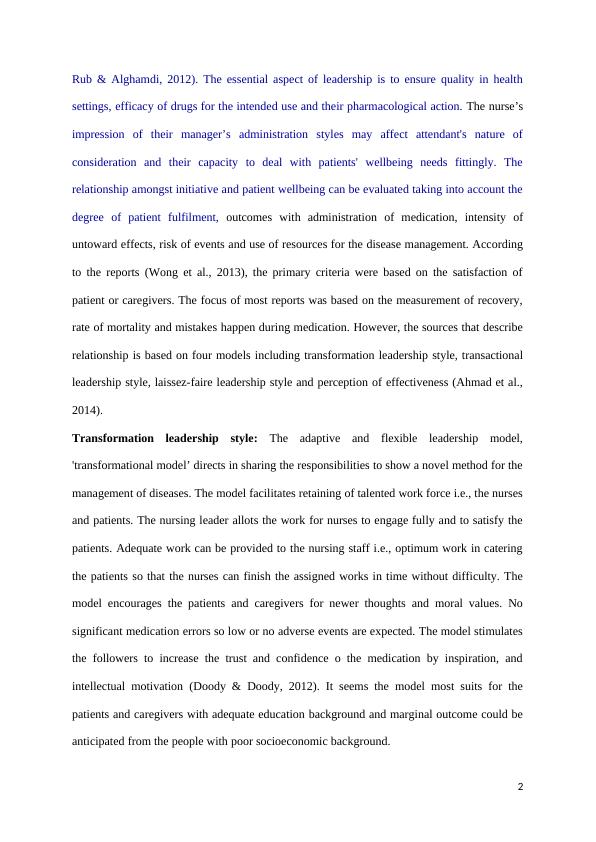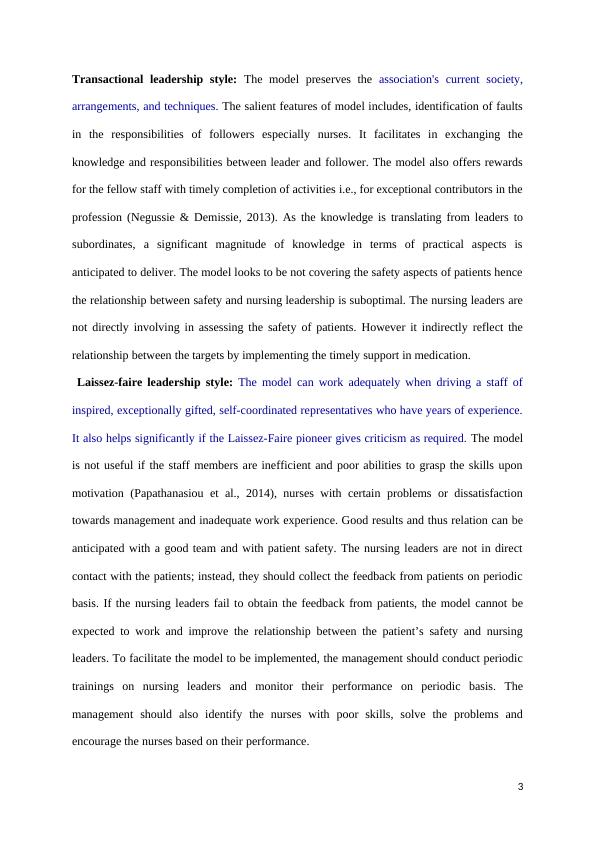Ask a question from expert
Analysis Relationship Report Between Leadership Styles And Patient
6 Pages1686 Words356 Views
Added on 2019-09-30
Analysis Relationship Report Between Leadership Styles And Patient
Added on 2019-09-30
BookmarkShareRelated Documents
Analysis relationship between leadership styles and patient safety1.0 IntroductionPatient safety events and efficacy in any healthcare setting are derived from a blend ofpractical techniques utilizing diagnostic results provided by cutting-edge technology (Weaveret al., 2013). The major safety events in the treatment of diseases include manageable adversedrug events. The adverse events are expected to happen in health care system however theyshould be controlled to the great extent in order to minimize the risk on patient health. Withthe capacity to assess a patient quickly, modern day healthcare steers in increasing the lifespan; more efforts have to be put for elderly patients and to have a better quality of treatment.Despite all of the advances in healthcare over the decades, one constant remains, leadership.The nurses can utilize the empirical approaches based on research findings, perceptions ofperformance data and clinical involvement for the benefit of improvements in organization(Merrill, 2015). The objective of the papers is to describe the relation between leadership innursing and patient safety, responsiveness, and recruiting of new professionals followed byconclusions2.0 Relationship between leadership styles and patient safety According to ‘Institute of Medicine’, the term patient safety refers to ‘the prevention ofdanger/harm to the heath patients’ by providing an attention towards the medication in termsof timely administration and adequate doses. The medication errors are expected to occur toinfluence the safety of patients and thus the errors should be minimized in order to promotehealth during hospitalization (Verschueren et al., 2013). The leadership is the capacity ofnurses to influence and monitor the performance of subordinates by providing quality inputs,motivating and instructing them for effective treatment in healthcare organization. There arediverse styles of leadership that supervisors of nurse steer the staff nurses in hospital (Abu Al1

Rub & Alghamdi, 2012). The essential aspect of leadership is to ensure quality in healthsettings, efficacy of drugs for the intended use and their pharmacological action. The nurse’simpression of their manager’s administration styles may affect attendant's nature ofconsideration and their capacity to deal with patients' wellbeing needs fittingly. Therelationship amongst initiative and patient wellbeing can be evaluated taking into account thedegree of patient fulfilment, outcomes with administration of medication, intensity ofuntoward effects, risk of events and use of resources for the disease management. Accordingto the reports (Wong et al., 2013), the primary criteria were based on the satisfaction ofpatient or caregivers. The focus of most reports was based on the measurement of recovery,rate of mortality and mistakes happen during medication. However, the sources that describerelationship is based on four models including transformation leadership style, transactionalleadership style, laissez-faire leadership style and perception of effectiveness (Ahmad et al.,2014). Transformation leadership style: The adaptive and flexible leadership model,'transformational model’ directs in sharing the responsibilities to show a novel method for themanagement of diseases. The model facilitates retaining of talented work force i.e., the nursesand patients. The nursing leader allots the work for nurses to engage fully and to satisfy thepatients. Adequate work can be provided to the nursing staff i.e., optimum work in cateringthe patients so that the nurses can finish the assigned works in time without difficulty. Themodel encourages the patients and caregivers for newer thoughts and moral values. Nosignificant medication errors so low or no adverse events are expected. The model stimulatesthe followers to increase the trust and confidence o the medication by inspiration, andintellectual motivation (Doody & Doody, 2012). It seems the model most suits for thepatients and caregivers with adequate education background and marginal outcome could beanticipated from the people with poor socioeconomic background.2

Transactional leadership style:The model preserves the association's current society,arrangements, and techniques. The salient features of model includes, identification of faultsin the responsibilities of followers especially nurses. It facilitates in exchanging theknowledge and responsibilities between leader and follower. The model also offers rewardsfor the fellow staff with timely completion of activities i.e., for exceptional contributors in theprofession (Negussie & Demissie, 2013). As the knowledge is translating from leaders tosubordinates, a significant magnitude of knowledge in terms of practical aspects isanticipated to deliver. The model looks to be not covering the safety aspects of patients hencethe relationship between safety and nursing leadership is suboptimal. The nursing leaders arenot directly involving in assessing the safety of patients. However it indirectly reflect therelationship between the targets by implementing the timely support in medication. Laissez-faire leadership style: The model can work adequately when driving a staff ofinspired, exceptionally gifted, self-coordinated representatives who have years of experience.It also helps significantly if the Laissez-Faire pioneer gives criticism as required. The modelis not useful if the staff members are inefficient and poor abilities to grasp the skills uponmotivation (Papathanasiou et al., 2014), nurses with certain problems or dissatisfactiontowards management and inadequate work experience. Good results and thus relation can beanticipated with a good team and with patient safety. The nursing leaders are not in directcontact with the patients; instead, they should collect the feedback from patients on periodicbasis. If the nursing leaders fail to obtain the feedback from patients, the model cannot beexpected to work and improve the relationship between the patient’s safety and nursingleaders. To facilitate the model to be implemented, the management should conduct periodictrainings on nursing leaders and monitor their performance on periodic basis. Themanagement should also identify the nurses with poor skills, solve the problems andencourage the nurses based on their performance. 3

End of preview
Want to access all the pages? Upload your documents or become a member.
Related Documents
Relationship between Leadership Styles and Patient Safetylg...
|6
|1662
|209
(Doc) A Review on Leadership in Nursinglg...
|22
|5484
|46
Medication Safety In Nursing Practice 8 Running Head; Nursing Practice Medication Safetylg...
|8
|3086
|295
Medication Safety: Causes, Effects, Strategies and Nursing Roleslg...
|7
|1518
|139
HNN320 Leadership and Clinical Governance Assignmentlg...
|13
|3463
|296
(PDF) Adverse drug events and medication errorslg...
|12
|3551
|45